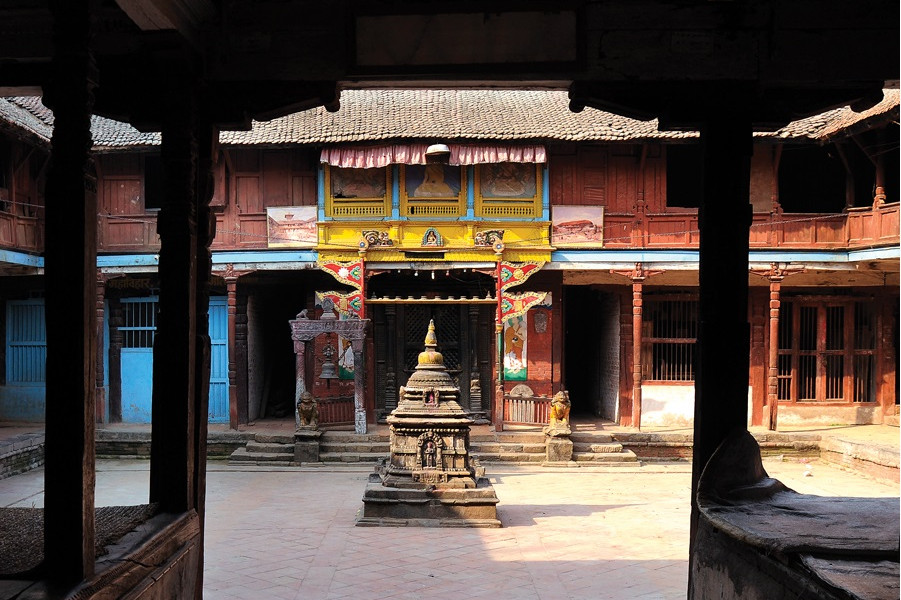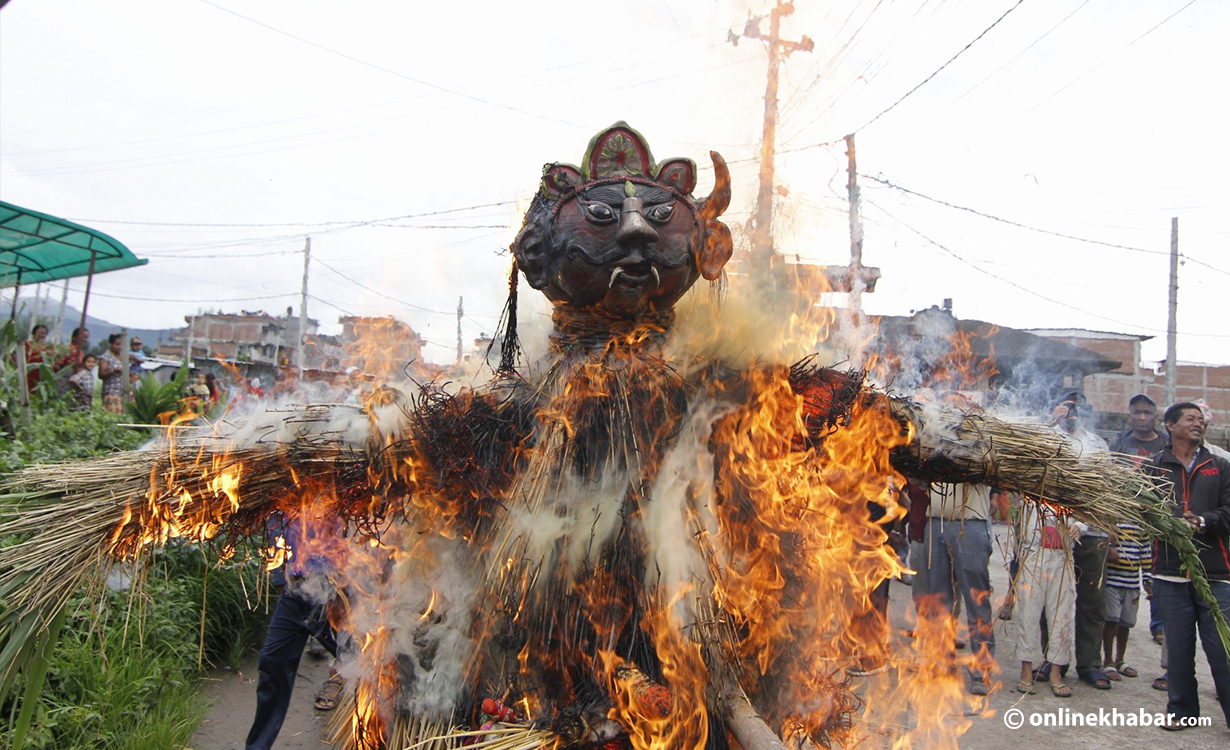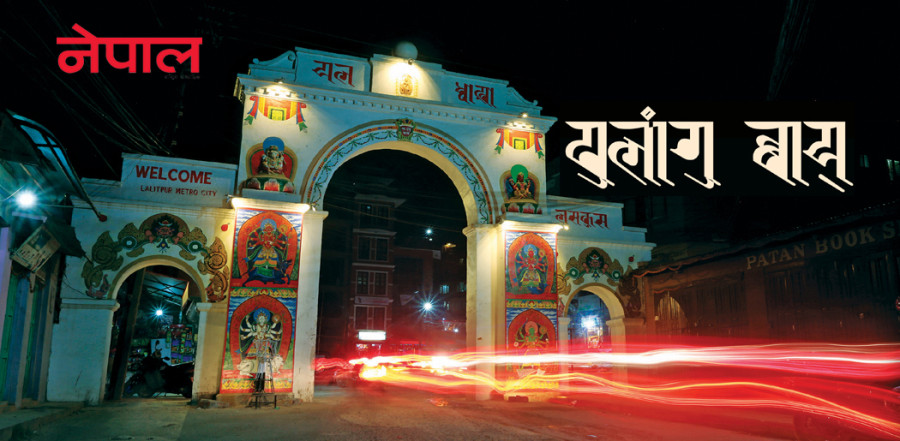By Marcia R. Lieberman
FOR many travelers, Katmandu is just a staging place for expeditions, the town they go through to get to the Himalayas. Trek organizers typically set aside a day for shopping and a standard half-day tour that whisks through some of the notable religious sites. Impressive as these are, they give scarcely a glimpse of the real architectural and artistic glories of the Katmandu Valley, which are the legacy of its indigenous inhabitants, the Newars.
Until conquered by the Gorkhas, who unified Nepal in 1768-69, the three cities of the Katmandu Valley -- Katmandu, Patan and Bhaktapur -- were separate Newar kingdoms. Their artists and craftsmen, whose skill was noted by visitors as early as the seventh century, left their stamp on the art of Tibet and China.
I got my first look at the distinctive Newari style several years ago when a Nepali friend took my husband and me on a short visit to Bhaktapur, seven miles east of Katmandu and the best-preserved city of the valley. We stepped into another world: there were temples bearing grand multi-tiered roofs, and superb palace facades covered with a tapestry of carved woodwork, window frames and balconies of startling intricacy. Among this confusion of shrines and palaces, artisans sat in their shop doorways crafting objects in metal, wood and clay, while farmers drove cattle and women sifted grain. We were immediately smitten, and had to come back for a closer look.
On a return trip to Nepal last June I asked our hotel manager to find us a guide to the architectural treasures of the Katmandu Valley. He introduced us to Dhurba K. Deep, a Newari poet and author of articles about Newari culture, with whom we arranged a two-day tour. Mr. Deep, a slender, sprightly man, is highly knowledgeable about his country's history, religion and art, and he regaled us with myths about the gods and legends of the Newari kings.
Over the centuries the Newars excelled at every art they turned their hands to. As architects, sculptors and painters they created innovative and powerful forms; throughout Southeast and Central Asia they were acknowledged masters at casting bronze and copper, arts they still practice.
But perhaps the quintessential Newari art was woodcarving. With their talent for design and invention, the Newars turned the window into a lavish display of the carver's skill and imagination; instead of a rectangular hole, the window became richly decorative, exuberant, playful. Lintels and sills were horizontally extended, often framing an intricate latticed center assembled without glue or nails, and embellished with abstract and figurative images: birds, snakes, flowers, demigods. The Newars created beguiling patterns on brick walls, much as Persians, Turks and others did on carpets.
On a grander scale, the Newari kings of each of the three cities built a Durbar (or Palace) Square, competing to fill it with the most magnificent palaces and temples.
This outpouring of architectural splendor was quickly apparent the first day of our tour, in Bhaktapur, a medieval city free of cars. A German group cleaned it up in the 1970's, and it has remained well kept. The population is still almost entirely Newari.
We left our car and driver near the city gate, guarded by two stone lions, and stepped into Durbar Square, a vast, magnificent space filled with temples and shrines, yet spacious and uncrowded. One has the impression of sculpture everywhere, peopling the square with the pantheon of Hindu gods and mythological creatures. The architectural ensemble is a knockout; one hardly knows what to look at first. But Mr. Deep had a plan, and he led us to the northern end of the square, to the old royal palace.
Fierce, protective deities, masterworks of Newari sculpture, guard the entrance to the palace -- the Sun Dhoka (Golden Gate), whose shining golden doors, pillars and tympanum, created in 1753 from lavishly gilded copper, are profusely adorned with fabulous beasts and important deities that also had power to safeguard the royal family within. The "55-window palace" (I did not count) presents a characteristic Newari facade of brick embellished with intricately carved windows. The local clay imparts sensuous colors to Newari bricks: soft rose shading to apricot or blue. Against this field of warm, subtle color, the dark, rich brown of wooden windows and balconies stands out boldly.
The palace courtyard displays elaborately carved roof struts, characteristic of the Newars. Visitors can peek through a doorway into a 14th-century inner courtyard, a sacred shrine accessible only to Hindus. A new wing of the palace houses the National Art Gallery, containing an excellent collection of Newari sculpture and painting. Guides can be hired who can unlock a room containing 17th-century wall paintings.
Bhaktapur's Durbar Square was dense with temples until several were destroyed in an earthquake in 1934, which created the spacious appearance it has today. But many fine temples survived, some topped with the high, tapered shikara-style roof of southern India, others in pagoda style with multiple tiers of roofs.
We were stepping down from a lovely octagonal temple when we spotted a religious procession carrying plates of flowers. We decided to follow, and as we wound through curving lanes, keeping the group in sight but also gazing right and left, fine Newari windows appeared everywhere, not just on palaces.
SURPRISES awaited everywhere. Strewn throughout the three cities are small former Hindu and Buddhist monasteries now occupied as houses. Their courtyards, adorned with intricately carved doors and windows and accessible to visitors, appear through open archways. Some of the finest temples are hidden in courtyards reached through narrow alleys, a secret world that is one of the delights of exploring a Newari city.
The procession halted in Taumadhi Square, second of Bhaktapur's three great squares. Here Mr. Deep turned our attention to the towering Nyatapola Temple, its stairs guarded by pairs of stone sculptures: at the base a pair of monumental wrestlers, above them elephants, then lions, griffins and other mythological creatures. Each pair is considered to have 10 times the strength of the larger creatures just below. Another multi-tiered temple has been converted into a restaurant, Cafe Nyatapola, where we stopped for soft drinks and a good view of the square.
Bhaktapur is still a city of farmers. Men edged past us carrying loads of hay or baskets of vegetables suspended from poles balanced across their shoulders. Sheaves of unhusked corn hung from upper-story windows; chickens and sheep roamed the streets.
In the smaller squares, women wearing the distinctive Newari dress -- black saris edged with red bands -- were spreading newly harvested grain on mats to dry. Potters' Square, lined with sheds where potters worked at their wheels, was filled with terra-cotta ware drying in the sun.
The most famous of all Newari windows, a fantailed peacock emerging from a delicate web of latticed wood, is at Pujari-math, a former Hindu monastery just off Dattatreya Square, the oldest of Bhaktapur's three grand squares. Dattatreya is the woodcarvers' center; studios are full of handsome carvings and the best of the colorful marionettes sold all over the valley. The Woodcarving Museum is in Pujari-math, opposite a Brass and Bronze Museum.
We finished the first day of our tour by driving to Changu, a small Newari agricultural village barely altered by tourism and the 20th century, on a steep ridge about four miles north of Bhaktapur. Its temple, Changu Narayan, occupies the center of an arcaded courtyard containing stone sculptures dating from the earliest Newar dynasty, the Licchavi period (A.D. 300-879). Its famous images of Narayan, one of the manifestations of Vishnu, have a serene but elemental force.
The next morning we drove to Patan (also known as Lalitpur), about 20 minutes from the center of Katmandu. It is now virtually part of Katmandu, separated only by the Bagmati River. Its Durbar Square, packed with an almost bewildering collection of temples, is the heart of the city's everyday life, with women washing clothes in an old carved water tank at one end and vegetable sellers at another. The palace and its courtyards are laden with treasure -- sculpture, dazzlingly intricate windows, and roof struts carved into magnificent figures. Other superb temples are found along Patan's back streets.
In the afternoon we visited Katmandu's Durbar Square, linked to other squares that wrap around the old royal palace. It is a thicket of temples, and pulses with life and color. People sit on temple steps selling oranges, lentils and spices, chatting with friends and giving haircuts. Porters march through the square with bales of hay and bolts of cloth; taxis, rickshaws, and bicycles loaded with bananas weave through the crowds.
Here is Kumari Bahal, home of Nepal's living goddess, the Kumari Devi, a young Newari girl considered to be the incarnation of Taleju, the special goddess of the kings of Nepal. A Kumari is selected when she is about 4 or 5, and replaced at puberty by another child. Visitors may enter the gate, guarded by stone lions, and view the courtyard, with its exquisitely carved windows and balconies. Mr. Deep gained us a glimpse of the Devi on condition that we not photograph her: a young girl in a red sari, her hair piled above her head, her eyes outlined in black, her expression masklike.
The vigor and astonishing variety of the religious imagination are boldly manifested in the square, and every major style of Newari architecture is present. Along with temples dedicated to deities more familiar to Western visitors, such as Shiva, Vishnu and Krishna, there are ferocious images of the fanged, grimacing Bhairab, demonic in appearance but a powerful defender of the faith. A splendid 17th-century palace facade of rose-colored brick with elegantly carved windows and roof struts, a royal display of Newari virtuosity, contrasts with the Kast hamandap (Sanskrit for Wooden Pavilion), the massive, foursquare 12th-century wooden structure that gave the capital city its name.
This most ancient of buildings is not cordoned off but used un-self-consciously by ordinary people, comfortably at home in the monuments of their culture. Inside the Kasthamandap we found a group of sari-clad women in one corner, sitting cross-legged on the floor, led in song by a Hindu priest. In another corner, men sat chatting with friends. Just outside is a waist-high shrine to Ganesh, the elephant-headed god who destroys obstacles and watches over new beginnings. (Mr. Deep said that despite its size it is the most important Ganesh shrine in Katmandu.)
Amid the tumult of the square I watched a young girl approach the shrine, touch her head to the floor, daub the image of Ganesh with vermilion powder, then pick up a flower petal from the shrine and put it on her head. In a moment of private, ancient ritual she had honored the god and taken onto herself some of his power.
In the world of the Newars, marketplace, palace and temple share space; art, faith and daily business flow together. Making the most of the Katmandu Valley When to Go
The Katmandu Valley has a mild climate and can be visited comfortably at any time of year. Winter days are sunny and not especially cold, evenings chilly enough for a sweater and jacket. Weather is ideal in spring and fall. During the monsoon season (mid-June through mid-September), days can be sunny and very warm and rain often falls from early evening through the night. The country code for Nepal is 977, the city code for Katmandu 1. Where to Stay
The 76-room Hotel Shangri-la, on Lazimpat, Post Office Box 655, telephone 412-999, fax 414-184, is a comfortable, attractive place with the loveliest garden in town and a charming terrace restaurant. Rooms are decorated with handsome drawings of Newari facades. A double room is about $110.
Hotel Vajra, 271-545 or 272-719, fax 271-695, 51 rooms in an old Newari house and garden, is interesting but inconveniently far from the center of Katmandu: it's hard to get taxis there. A double room is about $70.
The 80-room Katmandu Guest House in the Thamel district, 413-632 or 418-733, is popular with climbers and trekkers; there are many similar and cheaper hotels in the area. Where to Eat
Dinner for two with a liter of beer costs between $12 and $20 at most good restaurants. The Ghar-e-Kebab, on Durbar Marg, 221-711, has superb Indian food. A Newari master of the sarod, a stringed instrument similar to a sitar in appearance, plays every evening except Thursdays between about 7 and 8:30 P.M., and throughout dinner on Wednesdays. He is followed at 8:30 by a group who perform the romantic, slightly melancholy Indian ghazal songs except on Wednesdays, and throughout dinner on Thursdays. Thayabhu, just off Lazimpat, 411-570, has attractive decor and Nepali and Newari food, both similar to Indian food, the latter distinguished by interesting bean salads and spicy pancakes. Bhoe Chen, 228-787, is a small, simple but charming place above Kailash Bookstore, near Hotel Yak and Yeti, with very good Newari food. Bhancha Ghar, in a handsomely restored Newari house on Kamaladi, east of Durbar Marg, 225-172, is a bit more expensive, with Nepali food. Sights
The National Gallery of Art in Bhaktapur is open 10:30 A.M. to 4:30 P.M., until 2:30 on Fridays, and closed on Tuesdays. Traditional Newari paintings and statues. The Woodcarving and Brass and Bronze Museums in Bhaktapur are open 10 A.M. to 5 P.M., until 3 P.M. on Fridays, and closed on Tuesdays. The Patan palace courtyard is closed on Saturdays. The old palace of Katmandu is open 10:30 A.M. to 4 P.M. daily.
A taxi with driver may cost about $30 a day; the charge must be personally arranged. You can also reach Patan by bus and Bhaktapur by trolley-bus. Dhurba K. Deep's charge as guide is $50 a day; his numbers are 521-266 and 216-603. Should he be unavailable, hotels can find other guides.
A version of this article appears in print on April 9, 1995, Section 5, Page 12 of the National edition with the headline: The Artistry of the Newars.
https://www.nytimes.com/1995/04/09/travel/the-artistry-of-the-newars.html
 The Newari settlement, formed of dense population, share similar lifestyles and building methods. The Newari houses are narrow, rectangular shaped, made of exposed brick with finely detailed wooden carvings and tiled roof which ooze history and antiquity. Resided by a dense population, these houses are built following the perimeter of a courtyard, known as ‘Chowk’. Everyone living in and around the similar chowk, take it as their gathering point for all social activities or just casual meetings. The cluster of these houses is apparently possible for the uniformity in their design.
The Newari settlement, formed of dense population, share similar lifestyles and building methods. The Newari houses are narrow, rectangular shaped, made of exposed brick with finely detailed wooden carvings and tiled roof which ooze history and antiquity. Resided by a dense population, these houses are built following the perimeter of a courtyard, known as ‘Chowk’. Everyone living in and around the similar chowk, take it as their gathering point for all social activities or just casual meetings. The cluster of these houses is apparently possible for the uniformity in their design. The best kept secrets lie in the attic of Newari houses traditionally called ‘Baigah’ or ‘Buigal’. A small wooden staircase leads to the trap door, two heavy planks locked by chains, that closes off the stairway to the attic. Some use the attic as kitchen, while some as storerooms or place of worship where no one except the head of the family is allowed. The houses in the medieval era were built attached to one another, identical to each other to host feasts. Each attic attached to one another and were connected by doors. The doors are kept open at the same time to form a long passage to hold a communal feast. However, this design has seen changes due to the growing number of party and feast venues.
The best kept secrets lie in the attic of Newari houses traditionally called ‘Baigah’ or ‘Buigal’. A small wooden staircase leads to the trap door, two heavy planks locked by chains, that closes off the stairway to the attic. Some use the attic as kitchen, while some as storerooms or place of worship where no one except the head of the family is allowed. The houses in the medieval era were built attached to one another, identical to each other to host feasts. Each attic attached to one another and were connected by doors. The doors are kept open at the same time to form a long passage to hold a communal feast. However, this design has seen changes due to the growing number of party and feast venues.  The functional planning of the Newar houses is a mix of residential and commercial purposes. Traditionally, these were single family houses with shops or workshops on the ground floor, but with the saturation of building plots and expensive costs, the houses host more than one family today. The major modifications in the Newari house consists of updated hygienic facilities such as running water and toilets, replacement of traditional timber floor with concrete slabs, mud façade with cemented facade.
The functional planning of the Newar houses is a mix of residential and commercial purposes. Traditionally, these were single family houses with shops or workshops on the ground floor, but with the saturation of building plots and expensive costs, the houses host more than one family today. The major modifications in the Newari house consists of updated hygienic facilities such as running water and toilets, replacement of traditional timber floor with concrete slabs, mud façade with cemented facade. 









 पाटनस्थित हिरण्यवर्ण महाविहार
पाटनस्थित हिरण्यवर्ण महाविहार रातो मच्छिन्द्रनाथको जात्रा
रातो मच्छिन्द्रनाथको जात्रा पाटनको सुन्धारा
पाटनको सुन्धारा पुनर्निर्माणका क्रममा महाबौद्ध
पुनर्निर्माणका क्रममा महाबौद्ध